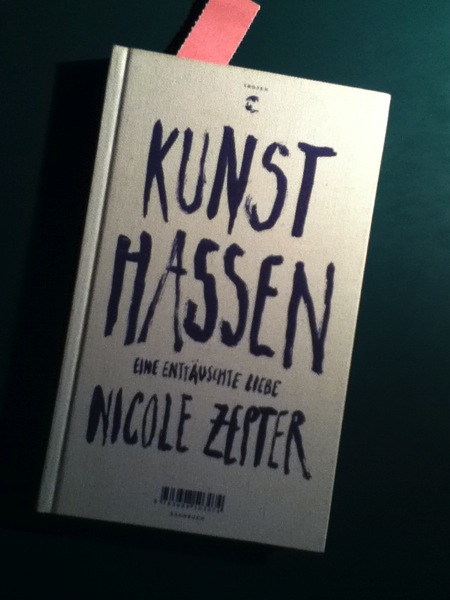Ein wenig zu hoch gelobt : “Kunst hassen” von Nicole Zepter

Sperrig. Arg verquast formuliert — duchweg. Leider.
So wie die Sprache, die überhöht unsäglich selbstgefällige gestelzte und vermeintlich Literatur-aristokratische Auswahlrhetorik zusammenhäkelt, die uns vollkommen dämliche Beschreibungen und Interpretationen so anbiedert, als seien diese wichtiger als die Kunst die es zu betiteln, erklären oder nur zu beschreiben gilt, so unbeholfen ataktisch wie eben diese semi-intellektuös infizierte Blasen-Blubber-Sprache sich uns pathologisch verkrampft in Museen und Ausstellungen aufgedrängt, so stolpert auch Zepter umher. Klebrig zäh, das Ganze.
Aber dennoch muß das Buch gelesen werden. Denn es gibt allzu wenige Annäherungen an das, was Frau Zepter offensichtlich interessiert — und uns auch : Kunst, mitsamt dem ganzen ‘Drum-Herum.
Außerdem hat Frau Zepter auch verdammt starke Momente, wenn sie dann endlich auch einmal deutlich inhaltlich — oftmals aber zu langatmig — kritisiert : “Kunst ist heute in den seltensten Fällen aufregende, grenzüberschreitende und ästhetisch eindrucksvolle, ja nachhaltige Kunst. Ist Kunst, wie sie heute produziert wird, überhaupt noch zeitgemäß? Ist die Galerie noch zeitgemäß? Was ist nur noch Verwaltung?”
In der Wortdynamik hat Frau Zepter eben leider mehr den braven verwaltenden Stil adaptiert. Nicht zu weit aus dem Fenster lehnen, nicht zu deutlich kritisieren — also keine Sorge, der Titel-gerecht erwartete [intellektuelle] Kunsthass ist hier nicht gedruckt worden.
Stark ist das Buch exakt da, wo weder Zepter daselbst, noch ihr Lektorat diese überhöhten Sprachwallungen der institutionalisierten Kunstszene imitieren können, eben in Zitaten : «Seth Siegelaub sagte: ‘Art is to change what you expect from it.’» oder «Die britische Autorin Sarah Thornton (7 Tage in der Kunstwelt) schreibt, Kunst sei Sport fürs Gehirn. Und: Leute fühlen sich besser, wenn sie regelmäßig Ausstellungen besuchen. ‘Art is a better mindexpander than drugs’»

‘Tropen’ Sachbuch; recht flexibler Einband. Taschenbuch-griffig.
Eine leichtere und mutigere Ironie, sehr viel bissiger in rheinisch-nordischer Sprachmixgewalt, eine Ironie die sich an Robert Hughes’ vorbildlicher Deutlichkeit und Klarheit messen ließe, die hätte ‘Kunst hassen‘ leichthin zu dem Standartwerk machen können, das inhaltlich überfällig ist.
A brief review of what made it into the best seller book ranks, these days, in german spoken circles interested in the Arts. This booklet, quite nice a print tho it could improve if only one would have believed in it, publisher’s-wise, from the beginning. One did not. misfortunately. And that exactly is what makes it sort of an misjudged and much overpraised piece : one didn’t quite believe in it. The publisher didn’t. Tho one could have. If only one would have had the spine to name it and spell it out. But — and that is what the reader will grasp, finally — they put a leash on Mrs. Zepter. Tho Zepter herself, as judged by her style, didn’t resist much, it looks. She apparently liked to be collared, intellectually. She, and the publishers, were too afraid to describe what’s going on in the Arts thus defying the purpose (?) of their own title : “Hate Art” (probably it should read more like “Do Hate Art” — as far as the native common german picks it up : ‘Kunst Hassen’ with kind of a subtitle to it which thus may read ‘Art : a gutted Love’).
There is not much to be read on why we should hate art. A pity. So we do get bored in style and phrases resembling what Zepter set out to criticizse : the dull boring stupid language and attitude adopted to present art to us. It is no good, light, entertaining reading; the folks from TimeOut Magazin certainly would summarize it : ‘it sucks’. Bad reading but of importance nonetheless. Because of its core themes : how is art presented to us ? aren’t we urged to hate art because of the ugly despicable pseudo-intellectual means par-adopted to sell it to us ? compared to the financial markets it appears that even the banking industry yields more trustworthy publications these days than the crap printed and publicized in the arts. And that all is meant to explain to us commoners that it is Art we perceive, we feel and fall for, and want to — should — adore, praise and admire with the greatest respect. Crap. It’s all, of course, about money. It became an art industry when they did invent, on an industrial scale, the profession of the ‘Art Critic’ in NYC.
However, as to us continental europeans who suffer from being able to to read Zepter’s booklet it is nevertheless worth doing so. This is because there are way too few publications, in german anyway, in which the issue of Understanding and Education, Presentation and Marketing of, and in, the Arts receives an attention that is of interest to those who like to visit a museum purely for the joy of it — those who still, naively enjoy, to believe in an Art that might be able to elicit in the feeling of wanting to become a better human. Still there is a crowd who’s stupid enough to seek a cultural enlightenment by visiting an art gallery, a museum, a vernissage or even read about it. Zepter’s book in this context is, by far, less worse than the overprized crap sold otherwise. So it won’t do much harm reading ‘Kunst hassen’.
